Our new post-election survey proves the first message guidance for progressive communicators and Democratic leaders in defining the agendas of the 116th Congress and President Trump.
There are 5 key takeaways:
- Americans want newly-empowered Democrats in Congress to provide a strong “check and balance” on Trump administration policies
- Democrats arrive in Washington with credibility on some of the major issues from the midterms – including health care, corruption, and gun violence
- The midterms were about change, and one part of that is Americans want less of the toxic politics that Trump has made his brand
- When talking about investigations or oversight, Democrats should be careful to focus on the facts, rather than process
- Democrats have a strong case to make on the economy and can persuade constituents they are on the side of working and middle-class people
1 | How to Approach Trump
Americans voted for a “check and balance” on President Trump and that’s exactly what they want Democrats to be.
This survey confirms what was found in the election-night exit polls: more voters meant to express opposition to Trump (43%) than support (29%). That gap widens slightly when the contrast is framed as a “check and balance” (46%) versus support for Trump (27%). Americans also gravitate toward “check and balance” language when asked directly what Democrats’ role in Congress should be in relation to the Trump administration. A majority (51%) pick this option when matched against “providing accountability” (23%), “oversight” (20%) or simply “standing up to the Trump administration” (19%). Importantly, it’s not just the middle of the electorate who prefer this language – “check and balance” is far and away the top choice among Democrats (58%), independents (57%) and Republicans (40%).
Americans want Democrats in Congress to do what their Republican counterparts won’t do – it’s not just about political opposition, it’s about restoring balance to the political system. Almost half (45%) of Americans agree (and just 19% disagree) the country is better off when a single party doesn’t control both Congress and the White House, and more say Democrats should stand up to the president (42%) than say they should work with him (32%). A majority (55%) also agree Democrats “should stand up to Trump and hold his administration accountable like the Republican Yes Men in Congress have failed to do.”
Democrats in Congress don’t have to give into Trump on anything, but they can’t reflexively oppose him without giving a reason.

Americans want their leaders to be the opposite of Trump the Divider.
A key question facing Democrats is whether they treat their opponents just like Trump treats them – or do they take a different tone? One thing is clear: voters rejected Trump’s divisive style. To this point, in the final stages of the campaign, Trump attempted to brand his political opponents as a dangerous “mob,” but most Americans were unconvinced. By a near 20-point margin (59% to 41%), most say this rhetoric was more about turning Americans “against each other” than it was about standing up for some silent, peaceful majority. That sentiment holds up in battleground congressional districts (57% to 43%), which are a net five points more Republican than the country overall; it also holds up among independents (68% to 32%).
So it comes as no surprise that in a battery of statements about how to lead the new Congress, the statement garnering the strongest agreement overall is Democrats should be “respectful of their political opponents, even when they strongly disagree.” Republicans are, tellingly, more supportive of this statement than all others tested – they know who Democrats’ “political opponents” are – but being respectful gets broad support with the Democratic base too and speaks to Americans’ frustration with the toxic political climate in Washington. Separately, less than half of the public (45% overall and 44% among independents) want the incoming Democrats to “fight fire with fire” when it comes to political disagreements. After a major change election, Americans are not looking for their new congressional leaders to mimic Trump, and voters may have been looking for something quite different when they put Democrats in charge of the House: by a 10-point margin (40% to 30%), 2018 voters say they trust Democrats more than Republicans to “[bring] Americans together instead of dividing them.”
Voters understand divided government means the two branches and houses of Congress may not agree on everything; yet, they do want Democrats to approach governing with an open mind. In a split-sample test, half of respondents were each shown a different Democratic statement paired against a Republican statement arguing, “Democrats in Congress are just going to obstruct President Trump on everything.” Both Democratic statements took a hard line on fighting back against the president’s agenda, “when it embraces corruption” or puts the wealthy ahead of people who work for a living. But respondents sided with the Democratic statement beginning with a promise to “work with President Trump when he’s right, but…” by a margin of 20 points (54% to 34%). The statement that lacked the “work with” language beat the Republican statement by a much smaller margin (47% to 41%).
Democrats should start by leaning into their strengths – and Republicans’ weaknesses.
As Democrats seek to set their agenda for the first 100 days of the new Congress, they would be wise to remember their strengths and what propelled them to power in the House. The new class of Democrats arrive in Washington with more credibility than Republicans on some of the most important issues facing the country, including protections for patients with pre-existing conditions, Medicare and Social Security, addressing gun violence, and addressing government corruption. On health care overall – the top issue for 2018 voters – Democrats lead by 16 points (48% to 32%), a lead that has widened over the course of 2018.
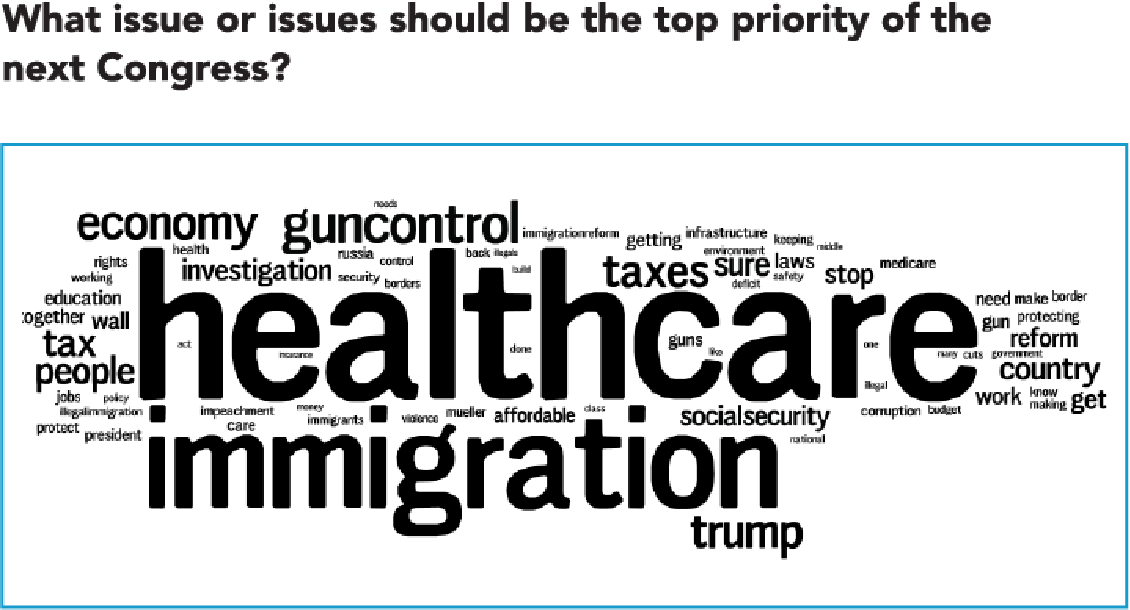
This list is not comprehensive but shows there are some issues on which Democrats can speak with authority, particularly pre-existing conditions and the social safety net. On corruption and special interests, the advantage is narrower, yet it still provides an opportunity for Democrats to lead the charge on a key issue.
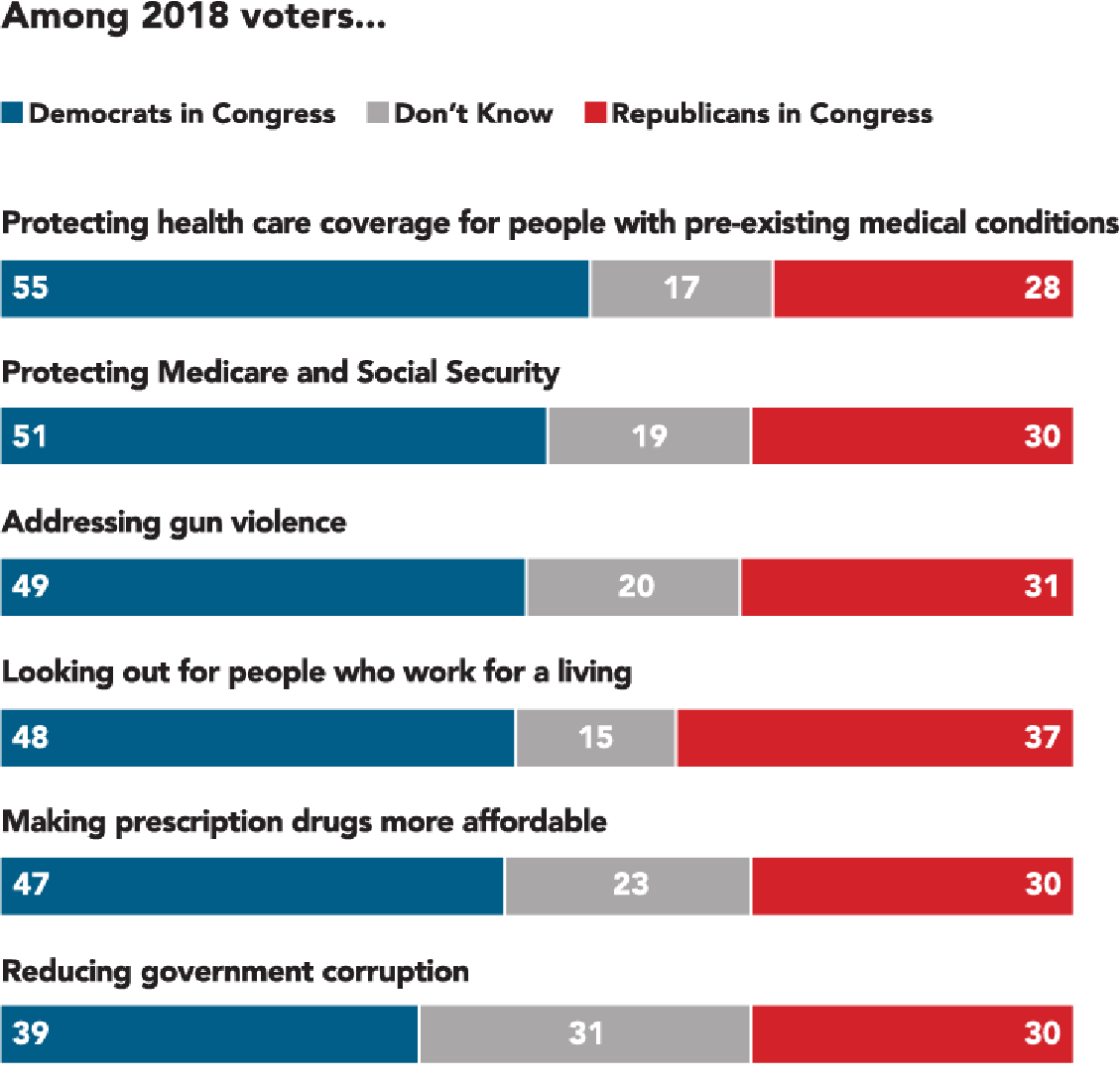
2 | How to Approach Corruption & Investigations
Corruption mattered in the midterms. Now, Americans want investigations into things that matter to their lives, not just life of Washington.
Nearly a third of 2018 voters (30%) cite government corruption and ethics as one of the top three issues behind their vote, behind only health care (49%), immigration (35%) and the economy (34%). Asked another way, “political corruption scandals involving the Trump administration or members of Congress” ranks third behind the Kavanaugh hearings and attempts to repeal the Affordable Care Act as major news events most influential for voters’ decisions.
As described in the previous section, reducing government corruption and special interest influence are two areas where Democrats in Congress lead, but have room for improvement. The trend is positive: on corruption, Democrats and Republicans were virtually tied in July, but in the latest survey Democrats held a 39% to 30% edge among 2018 voters and a 38% to 33% edge in battleground congressional districts. Americans also want Congress to make room for these issues on the oversight agenda: in a list of potential priorities for oversight, investigating the role of lobbyists in Washington and improving transparency both perform well, especially among independents.
When talking about the investigations, tout the facts, not the fact-finding.
It is a given that the incoming House majority will be conducting oversight over a variety of policies and institutions, and this research confirms Americans will generally embrace careful oversight. But too much focus on the investigative process rather than the findings could tarnish public perceptions of the endeavor. In a split-sample test, seven in 10 Americans agree (43% strongly) that, “Democrats should follow the facts when they see evidence of wrongdoing by the Trump administration, and go wherever the facts take them.” This sentiment appeals across political boundaries, with independents agreeing by 70% to 7% and battleground district voters by 69% to 13%. Yet agreement was far lower for those who saw a statement emphasizing process: “Democrats should use their new congressional powers to issue subpoenas and request documents from the Trump administration to uncover any wrongdoing by the Trump administration.” There’s still narrow agreement on net (42% agree to 36% disagree), but independents disagree (31% to 41%) and battleground district voters are divided (42% to 42%). Show – don’t tell.
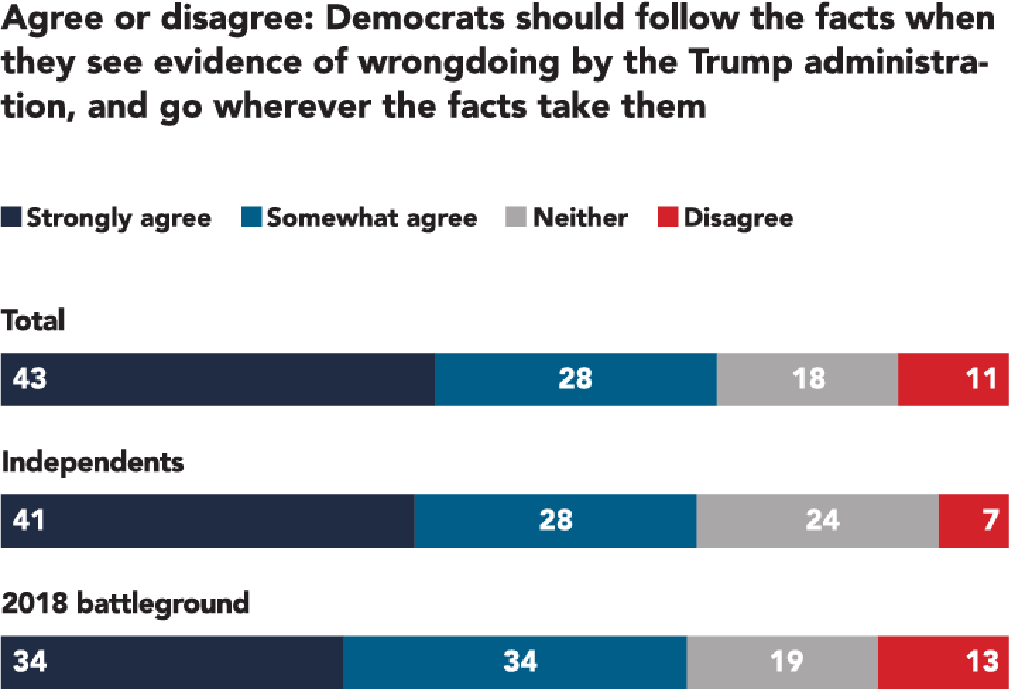
For health care oversight, focus on today’s battles.
When Americans are asked what sorts of investigations should be a top priority, health care rises to the top again, and the public see the most urgency in protecting pre-existing conditions and bringing down drug prices. Democrats in Congress already have an overwhelming advantage on health care in general (+16 over Republicans) and protecting pre-existing conditions (+25). When asked about where oversight is most needed, roughly half of Americans say a top priority should be investigating the manipulation of drug prices (51%) and the lawsuit that would end protections for pre-existing conditions (48%). Whether either of these investigations materialize, their high priority underlines the appeal of Congress using its oversight powers to stand up to powerful special interests on the issues that matter most to Americans today, rather than just engage what may strike some as partisan warfare. For comparison’s sake, 55% of Americans say it is important to look into whether Donald Trump is trying to sabotage the Affordable Care Act, but only 31% say it should be a top priority.
Why not both? With oversight, Democrats in Congress can find ways to speak to their rank and file and persuadable voters at the same time.
Huge enthusiasm from the Democratic base helped propel the 2018 House takeover. But 2018 was about more than that – Democrats won over millions of voters beyond its traditional base with appeals on health care and challenging special interests. Going forward, there are areas where the new House majority could build consensus among Democratic partisans and those won over outside their traditional base in 2018. For instance, when it comes to congressional oversight over areas such as drug prices, threats to protections for people with pre-existing conditions, or election tampering by Russian, Democrats and independents are united in their priorities.
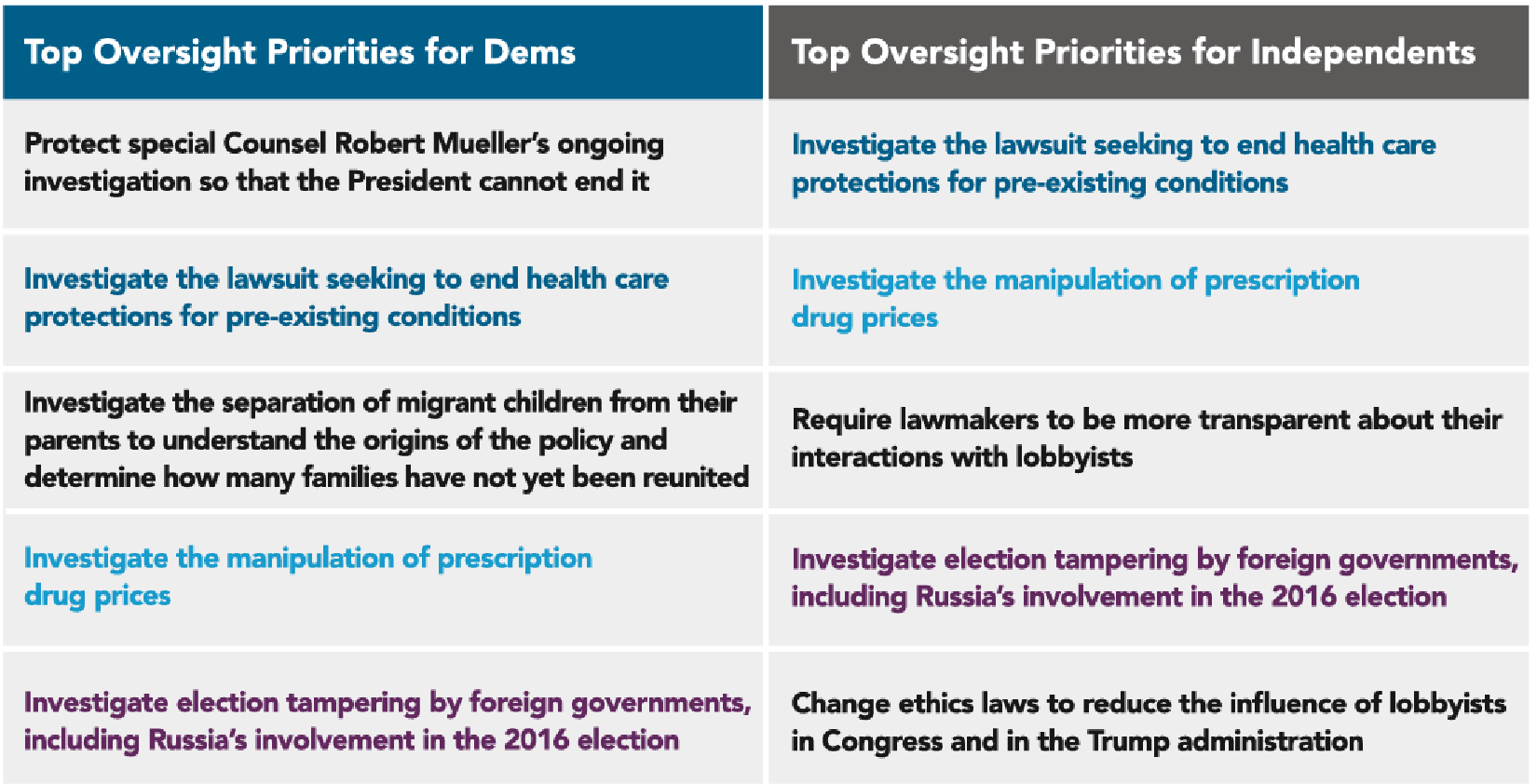
Democrats have a case to make on the economy.
Going into the midterms, Republicans’ one real advantage was on one of the biggest issues: the economy. Among 2018 voters, Republicans held an eight-point lead (45% to 37%) on handling the economy, and the advantage is wider in battleground districts. But Democrats in Congress have a powerful case to make that resonates with Americans and could encourage working people to support the Democratic agenda. In a message-testing exercise, we matched a Democratic economic argument emphasizing the rigged economic system disproportionately benefiting the wealthy while the middle class is left behind, against a pro-Trump argument pointing to record stock market highs and job growth. The full text and the results of a highlighting exercise can be seen below. Overall, the Democratic argument won over by a margin of 10 points (55% to 45%). It’s clear that in addition to stressing that the benefit goes to the top, keeping health care in the mix is also critical.
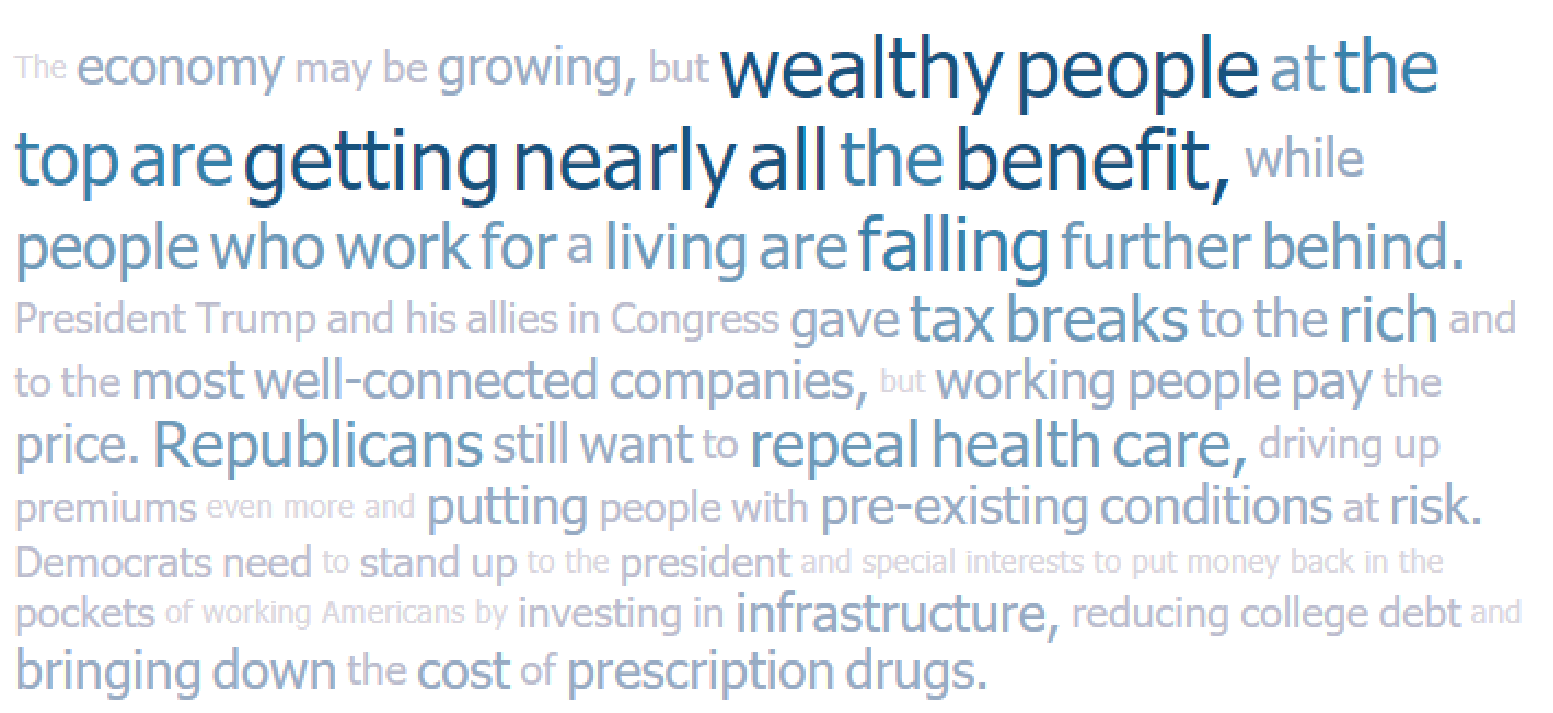
Respondents were asked to highlight the most convincing parts of the paragraph, and the larger text represents words that were highlighted more often. Graphic above shows data for independents. The full text of the message:
“The economy may be growing, but wealthy people at the top are getting nearly all the benefit, while people who work for a living are falling further behind. President Trump and his allies in Congress gave tax breaks to the rich and to the most well-connected companies, but working people pay the price. Republicans still want to repeal health care, driving up premiums even more and putting people with pre-existing conditions at risk. Democrats need to stand up to the president and special interests to put money back in the pockets of working Americans by investing in infrastructure, reducing college debt and bringing down the cost of prescription drugs.”
In addition, while Americans may be happy with the current state of the economy, the Republican tax bill continues to provide a clear opportunity for Democrats in Congress to demonstrate their policies will better support working people. Asked whether they were more persuaded by the Republican argument that the bill was good for the middle class and would grow the economy, or the Democratic argument that it was a giveaway to the wealthy at the expense of working people, Americans side with the Democratic argument by 58% to 42%.

